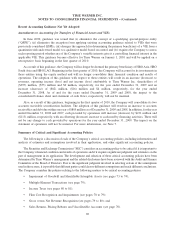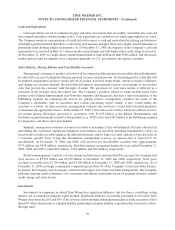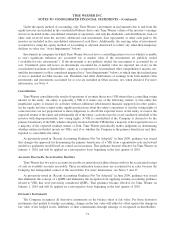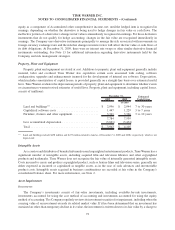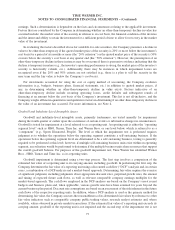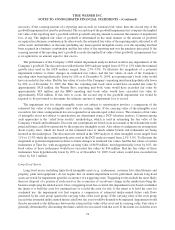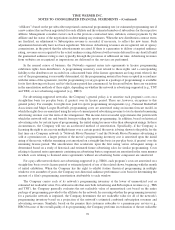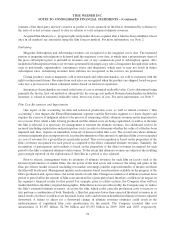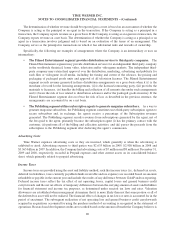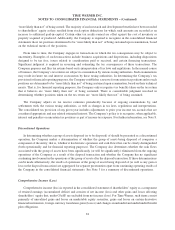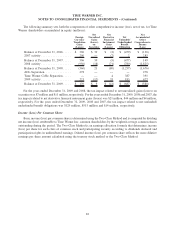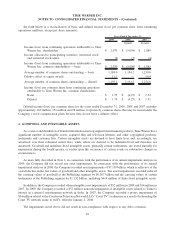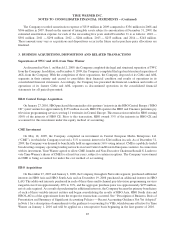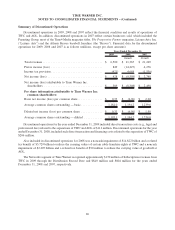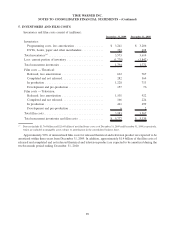Time Magazine 2009 Annual Report Download - page 91
Download and view the complete annual report
Please find page 91 of the 2009 Time Magazine annual report below. You can navigate through the pages in the report by either clicking on the pages listed below, or by using the keyword search tool below to find specific information within the annual report.Included in film cost amortization are film impairments primarily related to pre-release theatrical films of
$85 million, $84 million and $240 million in 2009, 2008 and 2007, respectively.
Barter Transactions
Time Warner occasionally enters into transactions that involve the exchange of advertising, in part, for other
products and services. Such transactions are recognized by the programming licensee (e.g., a television network) as
programming inventory and deferred advertising revenue at the estimated fair value when the product is available
for telecast. Barter programming inventory is amortized in the same manner as the non-barter component of the
licensed programming, and advertising revenue is recognized when delivered. From the perspective of the
programming licensor (e.g., a film studio), incremental licensing revenue is recognized when the barter
advertising spots received are either used or sold to third parties.
Multiple-Element Transactions
In the normal course of business, the Company enters into transactions, referred to as multiple-element
transactions. While the more common type of multiple-element transactions encountered by the Company involve
the licensing (both as licensor and as licensee) of programming (e.g., multiple titles in a single arrangement),
multiple element transactions could also involve elements such as investing in an investee while at the same time
entering in to an operating agreement or settling a dispute or legal matter with that investee. Multiple-element
transactions involve situations where judgment must be exercised in determining the fair value of the different
elements. The judgments made in determining fair value in such arrangements impact the amount of revenues,
expenses and net income recognized over the term of the contract, as well as the period in which they are
recognized.
If the Company has evidence of fair value for each deliverable in the transaction, then it accounts for each
deliverable in the transaction separately, based on the relevant accounting policies. However, if the Company is
unable to determine fair value for one or more elements of the transaction, the transaction is accounted for as one
unit of accounting which would generally result in revenue, or costs as the case may be, being recognized on a
straight-line basis over the term of the agreement.
In determining the fair value of the respective elements, the Company refers to quoted market prices (where
available), independent appraisals (where available), historical transactions or comparable cash transactions. Other
indicators of fair value include the existence of price protection in the form of “most-favored-nation” clauses or
similar contractual provisions and individual elements whose values are dependent on future performance (and
based on independent factors). Further, in such transactions, evidence of fair value for one element of a transaction
may provide support that value was not transferred from one element in a transaction to another element in a
transaction.
Gross versus Net Revenue Recognition
In the normal course of business, the Company acts as or uses an intermediary or agent in executing transactions
with third parties. In connection with these arrangements, the Company must determine whether to report revenue
based on the gross amount billed to the ultimate customer or on the net amount received from the customer after
commissions and other payments to third parties. To the extent revenues are recorded on a gross basis, any
commissions or other payments to third parties are recorded as expense so that the net amount (gross revenues less
expense) is reflected in Operating Income. Accordingly, the impact on Operating Income is the same whether the
Company records revenue on a gross or net basis. For example, if the Company’s Filmed Entertainment segment
distributes a film to a theater for $15 and remits $10 to the independent production company, representing its share
of proceeds, the Company must determine whether the Filmed Entertainment segment should record gross revenue
from the theater of $15 and $10 of expenses or record as revenue the net amount retained of $5. In either case, the
impact on Operating Income is $5.
79
TIME WARNER INC.
NOTES TO CONSOLIDATED FINANCIAL STATEMENTS – (Continued)


